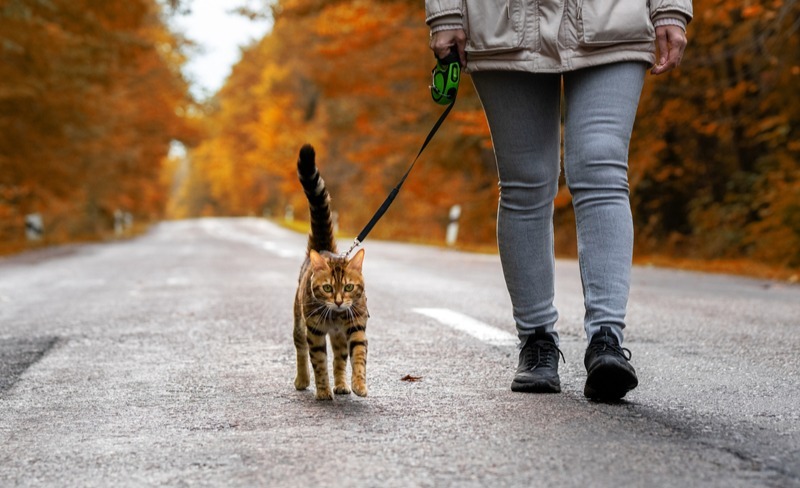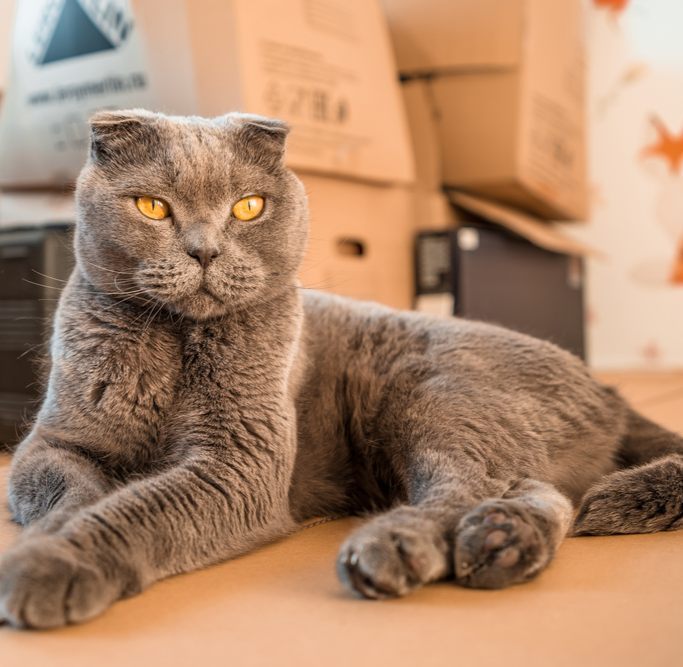Walking with cats: Tips for leash walking, hiking and camping with your cat
Teaching your cat to walk on a leash is highly recommended if you plan on taking her on any outdoor adventures, whether a wander around the neighbourhood or a trip further afield. Be aware, however, that not all cats will take to leash walking, nor is it recommended for all cats. If your cat is skittish, fearful and lacking in confidence, leash-walking outdoors with her might not be the best idea. On the other hand, if she is bold, unafraid and not easily stressed, and is always looking for any opportunity to go outside, she may just be an ideal candidate for it.
 Before you begin, be aware that leash walking a cat is very different from leash walking a dog. Unlike dogs, cats do not have the same desire to socialise with other animals, but they do enjoy smelling and exploring their surroundings. Also, cats do not behave the same as dogs on a leash; rather than responding to cues such as sit or heel, your cat will lead as she wanders around, and you’ll have to follow.
Before you begin, be aware that leash walking a cat is very different from leash walking a dog. Unlike dogs, cats do not have the same desire to socialise with other animals, but they do enjoy smelling and exploring their surroundings. Also, cats do not behave the same as dogs on a leash; rather than responding to cues such as sit or heel, your cat will lead as she wanders around, and you’ll have to follow.
The best time to train and prepare your cat to walk on a leash and harness is at a young age; preferably while still a kitten. Older cats can also be successfully trained, but it is likely to be a much slower process. Before you begin, you’ll need to get the correct equipment.
Cat harness and leash
Cats are great wrigglers. If you try to hook a leash to your cat’s neck collar, it probably won’t take her long to slip out of it and escape, which could put her in danger. A cat harness is essential if you’re going to try leash walking your cat. A proper, well-fitting cat harness will distribute pressure across multiple areas so that it is comfortable – and it doesn’t choke your cat – and it will prevent your cat from slipping out or escaping, keeping her safe.
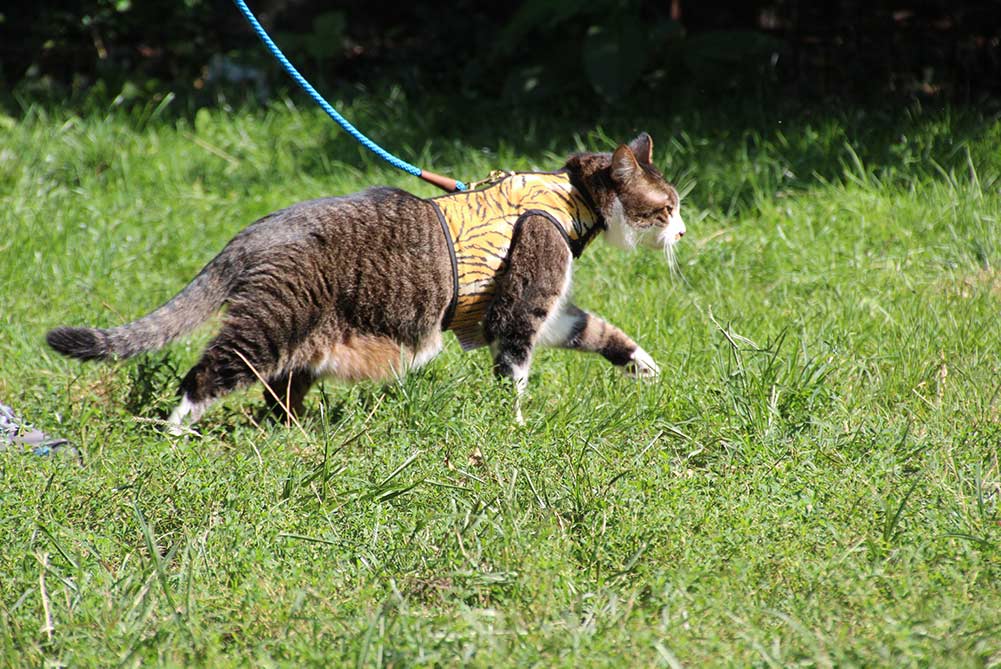
The leash serves to attach yourself to your cat in order to keep her away from danger, not to direct her where to go as it does for a dog. Remember that you will be following your cat on her chosen route, and not the other way around. If she is frustrated by a short leash, you may want to consider a longer or retractable leash, which can provide her with a little more freedom. Be aware that longer leashes require more care and vigilance as they can more easily tangle around her limbs (or yours) and cause an injury.
Begin by walking indoors
Before you take your cat for a walk outside, make sure you familiarise and get her comfortable wearing the harness and being “on-leash” while still inside. Applying a slow, step-by-step approach, and using rewards to reinforce desired behaviours will provide your best likelihood of success. This entails giving treats and praise at each step to reinforce the idea that wearing the harness is a good thing.
 To start, show the harness to your cat and let her sniff and touch it, then gently touch her with it, next drape it over her and only when she is completely comfortable, gentle put it on her. When she is comfortable wearing her harness, attach the leash to it and let her wander around the house, dragging the leash along behind her. When she is comfortable with this, let her wander about with you gently following while holding the end of the leash. Your goal should be to get your cat walking freely on the leash, but close enough that you can easily scoop her up in your arms, should the need arise.
To start, show the harness to your cat and let her sniff and touch it, then gently touch her with it, next drape it over her and only when she is completely comfortable, gentle put it on her. When she is comfortable wearing her harness, attach the leash to it and let her wander around the house, dragging the leash along behind her. When she is comfortable with this, let her wander about with you gently following while holding the end of the leash. Your goal should be to get your cat walking freely on the leash, but close enough that you can easily scoop her up in your arms, should the need arise.
To encourage positive associations with her harness and leash, it’s important to give her treats and praise every time she behaves as you want her to. Patience is critical; you need to go at a pace that is comfortable for your cat. Don’t try to tug her along or force her to walk. If she struggles or refuses to walk, take a break and then start again later at the level she was previously comfortable with.
Walking outdoors with your cat
Once your cat is comfortable being walked on the leash indoors, it’s time to try the great outdoors – but again, very gradually. Start off in the comfort and safety of your own yard, or another uncrowded and relatively private outdoor space. Only when you and your cat are comfortable with this, you can gradually venture out into increasingly challenging environments further afield. Keep walks brief at first and go to places that are quiet (or go at quiet times of the day) like back streets and small non-dog parks. Avoid dogs as much as possible and be extra vigilant at places like busy streets and public parks where dangers such as scary dogs are more likely, ready to scoop her up into your arms at any time.
Hiking and camping trips with your cat
Whether for a day hike or an extended camping trip, intrepid cat owners and adventurous, leash-trained felines can enjoy the great outdoors together. While there are some potential dangers cats might encounter on such expeditions, including wildlife, unfriendly dogs, parasites, and toxic pants, the positives of being in the great outdoors and sharing an adventure together can certainly outweigh any possible negatives!
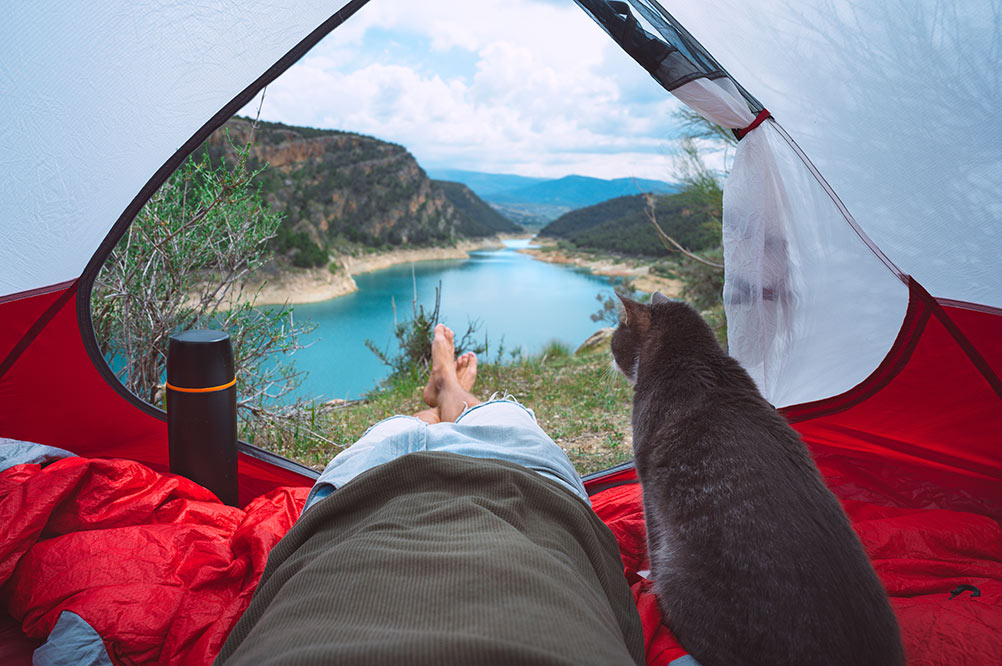
Your cat will need to be harness trained and willing to walk on a leash before you embark on a hike or camping trip. This will help you manage where she can go, especially if you have an emergency. Keeping your cat on a leash also helps to protect the local fauna. We also recommend that cats are trained to use a safe space like a cat backpack. Your cat can be placed inside the backpack when she gets tired or frightened on a hike, and as she grows more adventurous, she may even learn to balance on top of the pack or ride on your shoulders.
Acclimating your cat to a harness, leash and backpack is best undertaken gradually, so, start off in the familiar environment of your house and garden, then take short drives, preferably to quiet and secluded spots. Getting her used to being outdoors and comfortable with the sights and sounds is an important step. Initially, your “walks” may consist of letting your cat wander around on a long leash or carrying her in a backpack. Gradually increase the distance of your trips until your cat is comfortable no matter how long it takes or where you go. Finally, practice sleeping in the car or a tent in your backyard. Being patient with your cat while she gets used to these new activities and environments will be your best guarantee of a successful expedition.
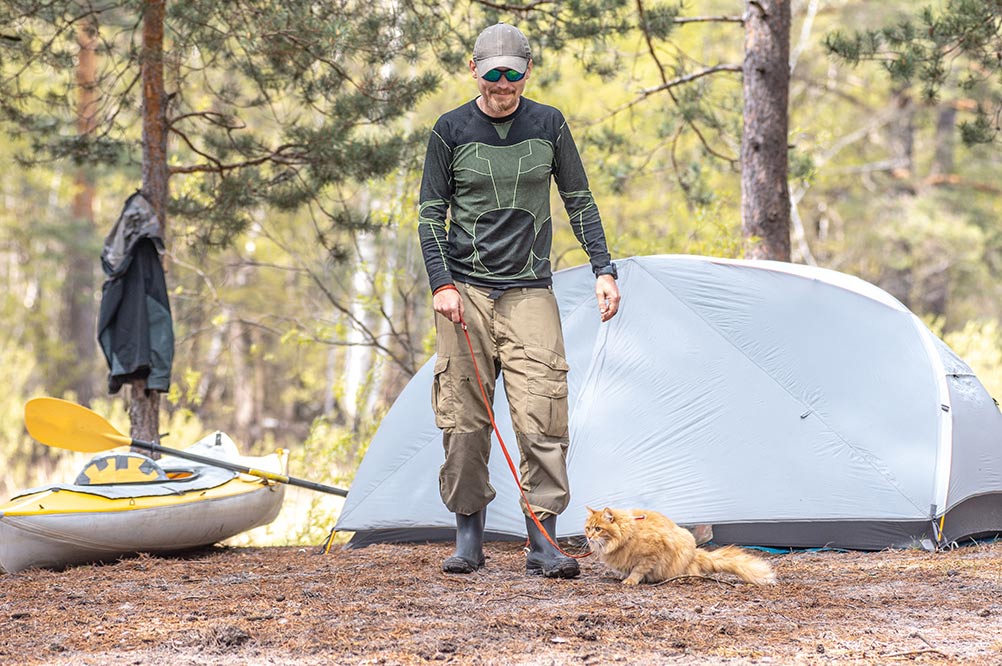
Don’t expect your cat to know to follow the trail, nor to be interested in following you. The outside world will be far more interesting, and she will want to explore it on her own schedule. A longer, retractable leash can be helpful as it can allows her to fall as much as 6 metres behind you, giving her a feeling of independence. Once she reaches the end of the leash, calling her name, along with a gentle tug, will let her know it is time to catch up. When she reaches you, give her a treat to provide positive reinforcement and to let her know that sticking close by will be rewarded.
Before you grab your cat and head for the car, there are some rules and recommendations to keep in mind
- Most national parks, historic sites or Aboriginal areas do not allow pets on trails and in wilderness areas, for their own protection and that of the local plant and animal life.
- If you’re taking a cat into an unfamiliar environment, you are responsible for the safety of the cat but also for the environment — so you cannot allow her to go roaming around and hunting animals.
- Always keep your cat in sight, make sure she is always harnessed, have an ID tag on the harness, and ensure she is microchipped.
The essentials to take with on an outdoor trip with your cat include:
- Toileting equipment – litter tray, litter, scoop, wipes, garbage bags
- Food and water – water bottles, cat food (regular or dehydrated), treats, collapsible bowls
- Harness, spare leash, cat jacket, cat backpack, sleeping bag/blanket

- Find out more about our cat insurance options
Inspirational feline travellers
Having some doubts whether you and your cat are up for the challenge? Look no further that these 3 feline adventurers and their intrepid humans for inspiration!
Van Cat Meow
Willow is a rescue cat who has been travelling around Australia in a campervan with her Tasmanian owner, Richard East, since May 2015. Richard has been documenting their time on the road here and here for years and has also written a book about their adventures called Van Cat Meow.
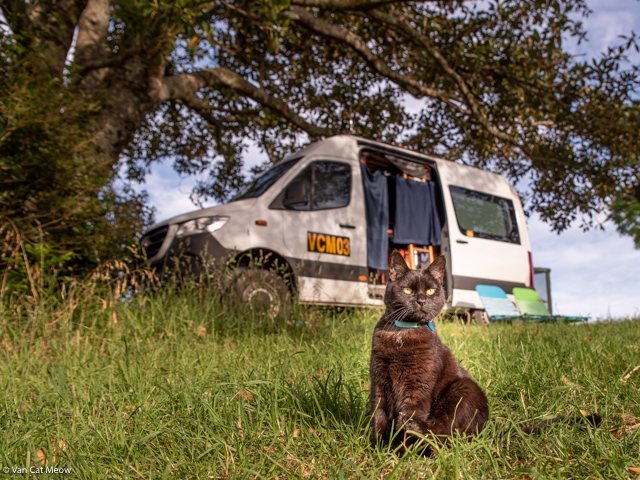
Kartika the travelling Bengal cat
Kartika’s owner, Lou Myers, gave up city life to live in the Australian outback where she works as a teacher. In her spare time, she and Kartika enjoy multi-day car trips exploring regional Australia. Lou makes sure that Kartika wears her harness and retractable leash wherever they go, to protect the wildlife. See their story here and follow their adventures here.

Denali – Adventure Cat
Since being rescued from a shelter 5 years ago as a kitten, Denali has been an adventure buddy to his owner Sandra, hiking, kayaking and travelling across the USA together. Sandra is an avid rock-climber and the intrepid pair even go climbing together, Denali riding in a backpack on Sandra’s back. You can follow their adventures here.
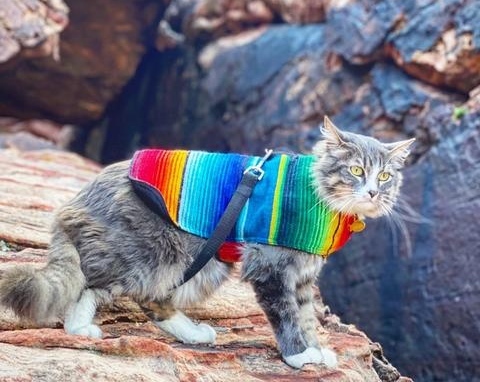
Bow Wow Meow Pet Insurance can help protect you and your cat should an unexpected trip to the vet occur.
- Find out more about our pet insurance options for cats
- Get an instant online pet insurance quote



